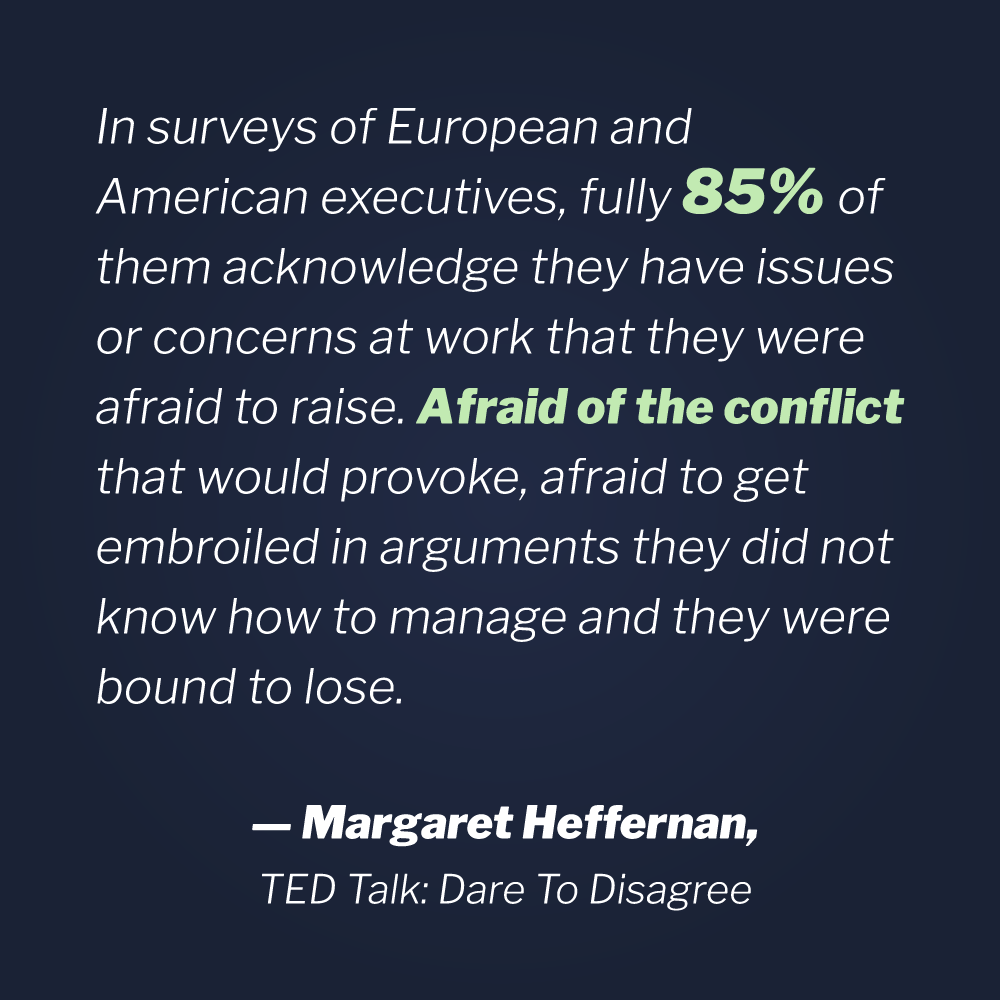I’m writing a new book and my research has caused me to reflect on the problems I’ve seen over the last 40 years that have most significantly impacted organizational performance.
What I’ve come up with is a pretty interesting list.
I’ve worked at a wide range of companies, spanning Fortune 500 companies to venture-funded startups, and the issues on my list have shown their ugly faces repeatedly — so I’m guessing you’ve experienced most of these yourself.
Early in my career the medical device company at which I worked hired a senior executive from General Electric. I was a business school grad and was hungry for advice. We were dealing with one of the issues on the list below and he made this very insightful comment — “Al, as you move between companies over your career, you will find that all that changes are the part numbers.”
He had dealt with this issue dozens of times before and, for him, this issue was just a routine part of the job. He had seen it before and would see it again.
This sage from GE was so right. As I’ve moved between companies, there were always new “part numbers” (I worked in manufacturing so there were lots “parts” and lots of “numbers” associated with those parts) to learn but the fundamentals of how an organization operates were constant.
As I’ve gotten older, I’ve been able to give this same insight to newcomers when issues arose — “nothing changes but the part numbers.”
What I’ve found is that this advice prevents people from getting frantic about a problem and, as a result, enables a calmer issue-resolution process. If people realize that what seems like a huge problem is actually pretty routine, they can focus on solving the problem rather than worrying about it.
However, over the last several years, I’m come to believe that this “insight” is flawed. Why? — because it implies that nothing can be done to prevent these issues. If your attitude is that history is going to repeat itself no matter what, then your only option is to react to an issue when it comes up.
Sure, having a “been there, done that” attitude can calm down a frenzied situation but it doesn’t provide much motivation to identify and fix the underlying problem.
I’ll come back to this point in a minute but, first, let me share my list.
Issues That Most Significantly Impact Organizational Performance
Again, this is my list based on my experience over the last 35 years but, given that “little changes but the part numbers” between organizations, I’m guessing that many of these will sound familiar.
1. Waiting too long to fire someone
This one is so common that old adages exist to address it: “Hire slow, fire fast” — “You can never fire someone too early” — “Be slow to hire and quick to fire.”
too early” — “Be slow to hire and quick to fire.”
But, how often have you actually seen this advice acted upon? Not often, I’m betting.
Instead, employees hang on too long to the detriment of both the company and themselves and, when someone finally does leave, everyone — the manager and peers alike — end up saying, “Boy, we should have done that sooner.”
Over my career, I could give example after example where there was someone in the organization that everyone knew should leave, for the benefit of the company and the employee, but it didn’t happen — for months, for years and, in some cases, never.
The question is why not?
2. People unwilling to share problems of which they are aware (except in a poisonous way —see below)
This one, for example, is the primary reason for the third leading cause of death in the United States — medical errors. Over 250,000 people die each year as a result of medical mistakes, which is almost 10% of all death.
Only heart disease and cancer cause more deaths.
Years ago I participated in a working group tasked with reducing medical errors. We ended up studying the airline industry which had seen a staggering reduction in fatal accidents over the last sixty years (fatal accidents per one million aircraft departures: 1959: 40: today: 0.2).
While there are a number of factors contributing to this reduction, our working group focused on just one.
This one factor was the change in the cockpit culture, resulting in co-pilots who were expected to readily identify problems rather than deferring to the captains.
Healthcare is still struggling to establish such a culture between attending physicians and the rest of healthcare staff (e.g., interns, residents, nurses, med-techs).
In the case of manufacturers, resolving this issue has been one of the foundational elements of the total quality management (TQM) movement in the United States since the 1980s. You might know of this movement by its more recent labels: ISO 9000, Lean manufacturing, and Six Sigma.
W. Edwards Deming is one of the founders of this movement. He is an American who couldn’t get anyone to listen to his ideas in the United States so he went to Japan in August of 1950. Many in Japan credit Deming as one of the inspirations for what has become known as the “Japanese post-war economic miracle,” when Japan rose from the ashes of war on the road to becoming the second-largest economy in the world.
In the 1980s, Deming brought his principles back to the United States and manufacturers started listening to him — but that was only after Japan beat the pants off of us in product quality, most notably in the car industry.
He offered fourteen key principles to managers, with these six focused on addressing the issue of “people being unwilling to share problems of which they are aware.”
- End the practice of awarding business on the basis of a price tag. Instead, minimize total cost. Move towards a single supplier for any one item, on a long-term relationship of loyalty and trust.
- Drive out fear, so that everyone may work effectively for the company.
- Break down barriers between departments. People in research, design, sales, and production must work as a team, to foresee problems of production and usage that may be encountered with the product or service.
- Remove barriers that rob the hourly worker of his right to pride of workmanship. The responsibility of supervisors must be changed from sheer numbers to quality.
- Remove barriers that rob people in management and in engineering of their right to pride of workmanship. This means abolishment of the annual or merit rating and of management by objectives.
- Put everybody in the company to work to accomplish the transformation. The transformation is everybody’s job.
These principles had several goals, but the primary one was creating a culture where people were willing to bring up problems they identified.
Despite over 30 years of effort, how often is such a culture omnipresent within organizations?
Sure, it might exist on the manufacturing floor of companies who have fully embraced Deming’s (or ISO 9000, Lean, Six Sigma) principles. But, even in those companies, does this culture exist throughout the organization?
If not, why not?
By the way, when Deming was asked, toward the end of his life, how he would wish to be remembered in the U.S., he replied: “I probably won’t even be remembered.” After a pause, he added, “Well, maybe … as someone who spent his life trying to keep America from committing suicide.” (Hillkirk, J. World-famous quality expert dead at 93. USA Today, December 21, 1993, pp. B1-2).
The U.S. may not have committed suicide but, due to our continued failures in fully embracing Deming’s principles, we are still killing people (e.g., medical errors) and organizational performance is still severely constrained.
3. Backbiting / Backstabbing
I know for absolute certain that you’ve experienced this one — speaking badly about another person without that person’s knowledge. This issue has been around since humans were dwelling in caves.
Above I said that one of the issues impacting organizational performance is “people being unwilling to share problems of which they are aware.” Well, you need to put a qualifier to that statement, don’t you?
People might be unwilling to share problems directly with the people involved with the problem — but they are more than willing to share problems behind the backs of those same people. In other words, people are willing to share problems in a poisonous way, but not in a productive way.
Again, why is that?
Well, its certainly not because people don’t know it is wrong. Check out these religious references to backbiting:
- Thomas Aquinas (Dominican friar, 1225 – 1274) classified it as a mortal sin
- The Qur’an compares it to the abhorrent act of eating the flesh of one’s dead brother
- Baha’i leaders condemned it as the worst of sins as it destroyed the “life and the soul” and provoked divine wrath
- “The north wind brings forth rain, and a backbiting tongue, angry looks” (Proverbs 25:23)
- A perverse man spreads strife, And a slanderer separates intimate friends (Proverbs 16:28)
Even if the world’s religions were not telling us that backbiting is wrong, we all know from our personal experience it’s one of the great poisons negatively affecting almost every organization that’s ever existed.
One thing you may not know is this well-established approach to dealing with a situation when someone is backstabbing another person to you. This approach requires asking two questions:
- “How does what you are telling me affect you?”
- “Have you talked to the person concerned?”
The first question separates gossip from a genuine grievance. The second question gives a clear message that speaking about another without his or her knowledge is not acceptable.
In my experience over the last 35 years, these questions aren’t often asked. And, even if they are, people rarely talk directly to the person being backstabbed about their concern.
I’m guessing you have had the same experience.
4. Expressions of a lack of self-confidence
This is another issue that negatively impacts organizational performance that I’m sure you’ve seen.
Here are four common manifestations:
- Not speaking up in meetings, which results in the organization not benefiting from each individual’s expertise
- Letting issues fester, which either destroys the morale of the individual or ends in a “blow up” with a wide range of disastrous outcomes
- Unwillingness to take risks or even try new things, which blocks even the slightest level of innovation from happening
- Committing to unrealistic goals or not having the ability to say no to a request
So that’s the list I came up with. In my 40 years of experience working in a wide variety of organizations, these are the four issues that most significantly impact organizational performance — and that are almost universal in their existence within organizations.
The “part numbers may change” between organizations, but these issues don’t.
Does my experience align with yours? If so, does that mean we should accept these issues as inevitable and just deal with them as they come up?
Throughout most of my career, I would have probably said yes to this question. I had seen these issues raise their ugly head over and over and over again and, if they were preventable, I just assumed someone would have figured out a way to do that. Since that hadn’t happened, I felt I just needed to accept them as a part of organizational existence and respond to them as they occurred.
What would your answer be to this question?
As I said at the beginning of this article, over the last several years I’ve had a change of heart about the answer to this question. Why? — because I started looking at these problems from a different angle.
I began searching for the root cause of these issues and, after some deep thought, came to this conclusion.
These four issues occur because people don’t want to deal with conflict
Think about each of these issues:
- Managers wait to fire an employee because they don’t want to deal with conflict
- People don’t share problems they’ve identified because they don’t want to deal with conflict
- People backstab others because they don’t want to deal with conflict (by addressing the concern directly with the other person)
- People let their lack of self-confidence manifest in the ways identified above because they don’t want to deal with conflict
Because people don’t want to deal with conflict, they work to avoid it at all costs.
“In surveys of European and American executives, fully 85% of them acknowledge they have issues or concerns at work that they were afraid to raise. Afraid of the conflict that would provoke, afraid to get embroiled in arguments they did not know how to manage and they were bound to lose.”
— Margaret Heffernan, TED Talk: Dare To Disagree (1955 – present)
What’s worse is that, besides the significant negative impact on organizational performance of these four issues, the avoidance of conflict has further ramifications:
- Festering concerns
- Resentment and lowered self-esteem
- Escalation to emotional or physical violence
This last one is obviously the most concerning. Organizations can survive poor performance but people getting emotionally or physically hurt can be devastating.
Anyway, once I got this root cause for these four issues in my head — people don’t want to deal with conflict — I started thinking about how to eliminate this root cause and came to this obvious conclusion:
If you want your employees to be willing to deal with conflict, you need to ensure they have the knowledge, skills, and abilities to address conflict effectively.
In other words, you need to provide your employees with conflict management training in order create a supportive culture.
You would think such training would be provided to everyone within organizations but that doesn’t happen.
“We train people to be expert in managing technology, numbers, finance, and the law. But this most fundamental characteristic of human interaction – conflict – is something we are somehow just supposed to figure out as we go along. But we don’t. And not knowing how to handle it, we prefer to ignore it and hope it goes away. The bad news is that it won’t go away; unresolved conflict festers and grows.”
— Margaret Heffernan — Beyond Measure: The Big Impact of Small Changes (1955 – present)
Let’s stop thinking that “all that changes are the part numbers” and, instead, do what’s needed to prevent the issues presented in this article from ever happening — train people to effectively manage conflict.








